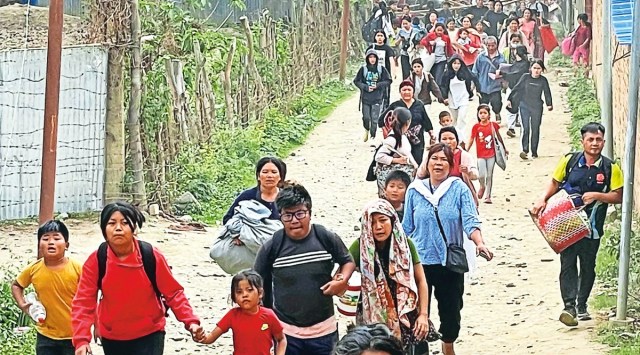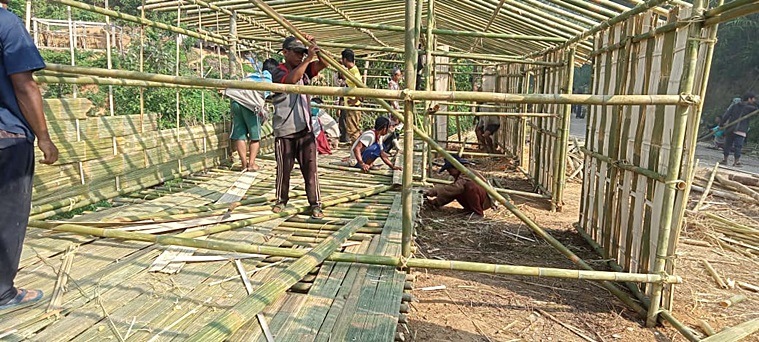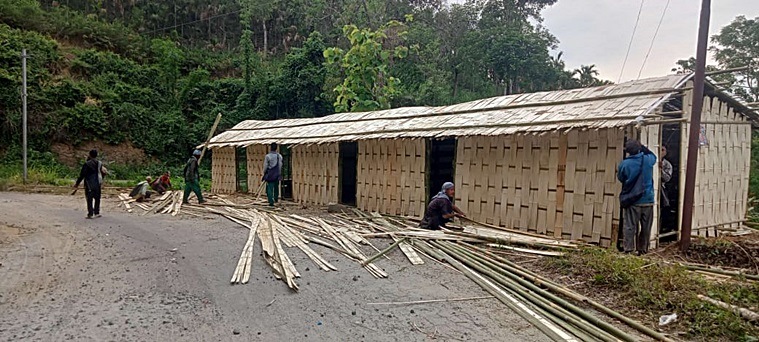
In May, Chief Minister Zoramthanga had written to the Prime Minister seeking financial assistance of at least Rs 10 crore to support those displaced by the ethnic violence. A delegation led by state cabinet minister Robert Royte had also visited Delhi earlier this month to press for funds.
 More than 1,500 children from “internally displaced families” have been admitted to schools in Mizoram till date. (Express photo by Sukrita Baruah)
More than 1,500 children from “internally displaced families” have been admitted to schools in Mizoram till date. (Express photo by Sukrita Baruah)
Aizawl district too has more than 4,000 displaced people and the YMA is running 12 relief camps in the city. Central YMA assistant secretary Malsawmliana said the organisation has appealed to the state government to set up more relief camps to ease the strain on civil society. Since violence broke out on May 3, around 37,000 have moved to relief camps within Manipur, and thousands have fled to other states. But Mizoram, which shares a 95 km border with Manipur, has felt the ripples of this conflict the most. The Kuki-Zomis, who are in conflict with the Meitei community in Manipur, share a deep ethnic bond with the Mizos of Mizoram, prompting many of those displaced to seek shelter there.
As of Monday evening, the total number of displaced people from Manipur in Mizoram was 12,162, of which 2,937 were staying in 35 relief camps, and the rest with family or friends. For nearly two months now, both the state government and civil society in Mizoram have been coming together to support these “internally displaced” people. The state government also constituted a 19-member Executive Committee on Internally Displaced Persons of Manipur in Mizoram led by Home Minister Lalchamliana to oversee relief and humanitarian assistance.
According to state Education Director Lalsangliana, more than 1,500 children from “internally displaced families” have been admitted to schools in Mizoram till date.
“This is from primary classes to class 12 in both private and government schools. This number will increase because people are continuing to arrive in Mizoram. They didn’t have documents but we still admitted them given the circumstances, and they have joined the ongoing classes. We don’t know if this is short term or for the long run, but we are facilitating admissions as much as we can,” he said.
Story continues below this ad
 Shelters being constructed in Kolasib for those displaced (Express Photo)
Shelters being constructed in Kolasib for those displaced (Express Photo)
This influx comes at a time the state is preparing for legislative assembly elections later this year. Mizoram also has around 35,000 Chin refugees – of the same tribal ethnicity as the Kuki-Zomis – fleeing civil war in Myanmar, whom the state took in despite central government directives to not do so.
Not just the government, the state’s civil society, which has been playing a central role in relief and aid, is feeling the strain as well.
Relief camps have been set up by village councils in conjunction with civil society organisations, particularly the influential Young Mizo Association, and with the support of the district administration. In Kolasib district, sheltering the highest number of such displaced people at 4,415 as of Tuesday night, the YMA and village councils have constructed temporary houses made of bamboo.

Temporary houses made of bamboo in Kolasib, which has the highest number of such displaced people (Express Photo)
“Every hour we have refugees arriving in the district,” said Thomas, president of the YMA sub-headquarters in Kolasib. “We collect clothes, rice and money from our people. Whatever they want to give. Then we calculate and distribute it equally among the refugees.”
Story continues below this ad
Around 1,480 of those displaced are staying in relief camps in the district. The biggest camp, with more than 300 people, has been set up by the district administration in Thingdawl. The other 13 are being run by village councils and the YMA. Running on goodwill and donations, the functioning of these camps is precarious.
“We have not asked for any kind of materials or money from the government; we are providing whatever we can. But we are finding it difficult, we don’t have any money to continue. We are dependent on whatever the people are donating,” he said.
Aizawl district too has more than 4,000 displaced people and the YMA is running 12 relief camps in the city. Central YMA assistant secretary Malsawmliana said the organisation has appealed to the state government to set up more relief camps to ease the strain on civil society.
Home Commissioner Lalengmawia said that those displaced should ideally be “repatriated”.
Story continues below this ad
“But they say they are not willing to go back until the situation goes back to normal. It is the Manipur government’s responsibility to help them get back, but they have not approached us about this,” he said.
Asked about his state’s efforts towards the return of their residents, Manipur government spokesperson and minister Sapam Ranjan Singh said, “Within the state, we are working towards rehabilitating and providing relief materials to all those who are in relief camps. The CM himself has been going and visiting them, and we will be providing prefabricated houses to them… Our CM is in touch with the Mizoram CM. It has been peaceful for 15-16 days now in the state, and things will get back to normal. We hope that the people come back to the state, be it to Churachandpur or Imphal or wherever. People have already started coming back from Delhi and Guwahati.”



 More than 1,500 children from “internally displaced families” have been admitted to schools in Mizoram till date. (Express photo by Sukrita Baruah)
More than 1,500 children from “internally displaced families” have been admitted to schools in Mizoram till date. (Express photo by Sukrita Baruah) Shelters being constructed in Kolasib for those displaced (Express Photo)
Shelters being constructed in Kolasib for those displaced (Express Photo)






